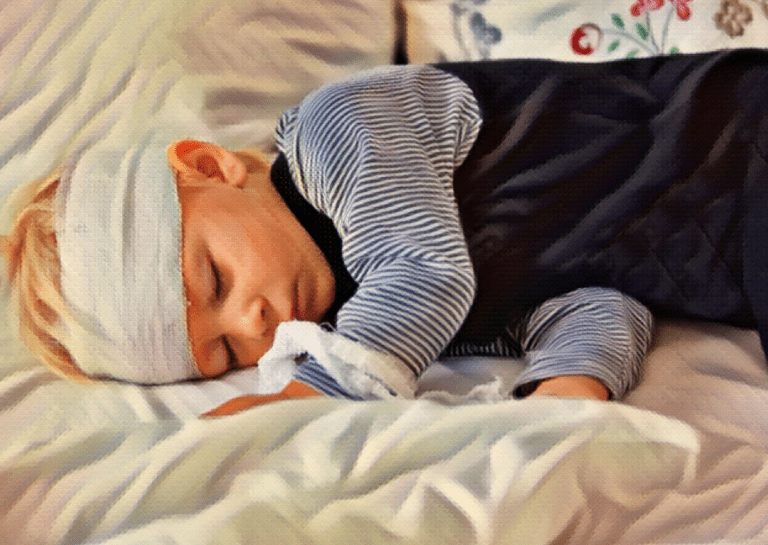Head injuries are common occurrences in infants and children and can happen through sporting activities, outdoor play, bike riding, or simple accidents. Although minor blunt head trauma is rarely serious, in some cases it can cause brain injury and must be closely monitored.
Head injuries are approached differently depending on the age of the child. This article will discuss the diagnosis and treatment of head injuries in children and infants younger and older than 2 years old separately.
Causes of head injury
Head injuries occur most frequently in children and infants younger than 2 years old. Most head injuries are caused by falls, vehicle collisions, projectiles, assaults, and pedestrian/bicycle accidents.
In infants and children, head injuries can happen during playtime or through playing sports. In fact, people engaged in contact sports are more likely to sustain concussions and similar head injuries.
Classification of minor blunt head trauma
Ages 2 and under
For children aged 2 years and younger, minor blunt head trauma is described as history or evidence of blunt trauma to the head occurring in an alert and responsive infant. An infant suffering from minor head trauma should wake up to a voice or light touch or be otherwise alerted.
This definition is different for younger infants because clinical assessment proves more difficult for this age group and infants with intracranial injuries tend to be asymptomatic. Furthermore, abusive head trauma is common in infants and can cause skull fractures and clinically important Traumatic Brain Injuries (ciTBIs).
Ages 2 and up
Mild blunt head trauma in previously healthy children aged 2 and up is diagnosed using the following criteria:
- A score of 14 or 15 on the Glasgow Coma Scale (GCS) — a scale used to describe a patient’s level of consciousness.
- An absence of abnormal findings from the neurological examination.
- An absence of evidence for skull fractures.
Traumatic Brain Injury (TBI):
According to the World Health Organization and the Centers for Disease Control and Prevention, mild traumatic brain injury is defined as an acute brain injury that is associated with one or more of the following:
- Confusion or disorientation
- Amnesia lasting less than 24 hours
- Loss of consciousness lasting 30 minutes or less
- Seizures
TBIs include epidural and subdural hematomas (ruptured blood vessels causing bleeding in the brain) and cerebral contusions (bruising of the brain).A ciTBI is a head injury that is serious enough to warrant neurosurgical intervention, extended observation in hospital, and/or endotracheal intubation (placement of a breathing tube in the windpipe).
In young infants and children, there may be a ciTBI present even if head trauma appears to be minor. Around 3 to 10 percent of infants under age 2 have been shown to have sustained a brain injury when neuroimaging is used. This number is approximately 5 percent in children older than 2, while 1 percent will have a ciTBI that may require further treatment.
The possibility of a hidden brain injury makes it all the more important to seek medical attention right away if your child has suffered a blow to the head.
Concussion
A type of mild TBI, concussions are defined as trauma-induced brain dysfunction without demonstrable structural injury on neuroimaging. Concussions occur due to rapid rotational acceleration caused by direct trauma — e.g. bumps, jolts, or falls.
Concussions can also be caused due to direct blunt trauma to the face, neck, or anywhere else on the body when the force is transmitted to the head. Neurological impairment after a concussion is generally short-lived, but sometimes symptoms can develop over minutes or hours.
Concussions are a common result of sports-related accidents and occur most frequently in boys playing collision sports, such as football, rugby, and ice hockey. Girls who play soccer, field hockey, and lacrosse are also at a higher risk of sustaining a concussion.
Symptoms of concussion:
- Headache
- Confusion or disorientation
- Memory problems
- Slurred speech
- Imbalance
- Inattentiveness/clumsiness
- Vomiting
- Dizziness
When to see a doctor
In most cases, a head injury will not pose a serious health risk to an infant or child. However, the younger the child is, the more difficult it can be to notice the symptoms of brain injury.
As we saw above, infants younger than 2 years old with TBI are often asymptomatic and the damage can appear less serious than it really is.
That’s why it’s worth taking your child to the doctor after they’ve sustained a head injury to have them checked out. A doctor will be able to rule out the possibility of brain injury and decide whether or not your child needs further tests and treatment.
